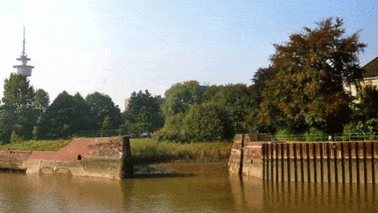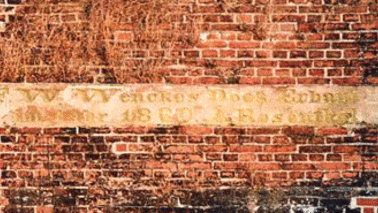
The Wencke Dock and other historic dock remains on the River Geeste
In the first half of the 19th century, Bremerhaven and a little later Geestemünde developed as a significant shipbuilding location on the German North Sea coast. But ship repairing also became an important business, due to the rise of overseas transportation arriving at and departing from the Weser. The narrow Geeste River forced the construction of dry docks of English design on the bank of the river, each being a very costly enterprise. In the dry docks, the ships could be repaired beneath the water line.
Between 1837 and 1865, six dry-docks in all were built on the River Geeste:
| Johann Lange | 1837 - 1840 |
| Friedrich Wilhelm Wencke | around 1845 |
| Schau & Oltmanns | 1853 - 1856 |
| Johann Carl Tecklenborg | 1853 - 1855 |
| Johann Lange | ~1860 - 1865 |
| Hermann Friedrich Ulrichs | 1864 - 1865 |
After 1871, further dry docks were built in Bremerhaven, but this time at the Neuer Hafen and Kaiserhafen basins.
A first-rate technical monument is the dry dock of Friedrich Wilhelm Wencke, still partly preserved on the Geeste. Wencke founded a shipyard in 1833. The original dry-dock, constructed about 1845, was built from timber in a quite simple fashion. After Wencke managed to purchase the premises which until then had been leased from the State of Bremen in 1856, he could now envisage a dock conversion. This job was completed in 1860. Now the dock (length 86 metres, gate beam 15 metres) was partly framed by stonework. After the Wencke yard wound up in 1900, the dock was used by other shipyards until 1945. Then it was filled in with debris from the wartime ruins. A restoration from 1977 to 1979 excavated the original area again. The largest part of the site is still filled up, but the edges can be seen and show the dimensions.
The European “Seaport” project, planned to boost tourism in a number of selected North Sea ports, will also emphasise the changes in Bremerhaven shipbuilding industry. In this respect, the preserved Wencke dock will play an important role. Furthermore, remains of the entrances to the later Lange Dock and, on the other bank of the river, the Tecklenborg dock can still be seen today.


